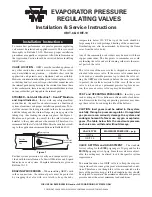
FOR USE ON REFRIGERATION and/or AIR CONDITIONING SYSTEMS ONLY
COPYRIGHT 2003 BY SPORLAN VALVE COMPANY, WASHINGTON, MO 63090
Installation & Service Instructions
ORIT-6 & ORIT-10
EVAPORATOR PRESSURE
REGULATING VALVES
Installation Instructions
To insure best performance, evaporator pressure regulating
valves must be selected and applied correctly. This is covered
thoroughly in Bulletin 90-20. However, proper installation
procedures are equally as important. All of the information in
the Application Section should be reviewed before installing
ORIT valves.
VALVE LOCATION
– ORIT's must be installed upstream of
any other suction line controls or accessories. These valves
may be installed in any position . . . whichever best suits the
application and permits easy adjustment and accessibility.
However, consideration should be given to locating these valves
so that they don't act as an oil trap or that solder cannot run into
the internal parts during brazing in the suction line. Since these
valves are hermetic, there is no way to disassemble them to clean
out any solder that gets trapped in the internal parts.
STRAINER – Catch-All Filter-Drier
®
– See
•
All
®
Moisture
and Liquid Indicator
– Just as with any refrigerant flow
control device, the need for an inlet strainer is a function of
system cleanliness and proper installation procedures. To in-
stall the strainer, the tubing is inserted in the valve connection
until the tubing and the strainer flange ring are up against the
tubing stop, thus locking the strainer in place. See Figure 1.
Moisture and particles too small for the inlet strainer are
harmful to the system and must be removed. Therefore, it is
recommended that a Catch-All Filter-Drier be installed accord-
ing to the application recommendations in Bulletin 40-10.
Further system protection is easily and inexpensively pro-
vided with the installation of a See•All Moisture and Liquid
Indicator on every system. Complete information is given in
Bulletin 70-10.
BRAZING PROCEDURES
– When installing ORIT's with
solder connections, the internal parts must be protected
by wrapping the valve with a wet cloth to keep the body
temperature below 250°F. The tip of the torch should be
large enough to avoid prolonged heating of the connections.
Overheating can also be minimized by directing the flame
away from the valve body.
Any of the commonly used solders may be used with these
copper connections. The key points to remember are: avoid
overheating the valve and avoid running solder into the inter-
nal parts of the valve.
The valve core of the access valve is shipped in an envelope
attached to the access valve. If the access valve connection is
to be used as a reusable pressure tap to check the valve set-
ting, the ORIT must be brazed in before the core is installed
to protect the synthetic material of the core. If the access
valve is to be used as a permanent pressure tap for any rea-
son, the core and access valve cap may be discarded.
TEST and OPERATING PRESSURES
– Inert dry gases
such as nitrogen, CO
2
or helium are often used for leak detec-
tion. Excessive leak testing or operating pressures may dam-
age these valves by reducing the life of the bellows.
CAUTION: Inert gases must be added to the system
carefully through a pressure regulator. Unregulated
gas pressure can seriously damage the system and
endanger human life. Never use oxygen or explosive
gases. The table below lists the maximum pressure
each valve can withstand without damage.
VALVE SETTING and ADJUSTMENT
– The standard
factory setting for the
0/50
psig range is 30 psig and for the
30/100
psig range it is 60 psig. Since these valves are adjust-
able, the setting may be altered to suit the specific system
requirements.
The main function of an ORIT valve is to keep the evapora-
tor pressure above some given point at minimum load condi-
tions. Therefore, even though the valves are selected on the
basis of the pressure drop at full load conditions, they should
be adjusted to maintain the minimum allowable evaporator
pressure under the actual minimum load conditions.
E
P
Y
T
E
V
L
A
V
g
i
s
p
–
E
R
U
S
S
E
R
P
M
U
M
I
X
A
M
6
-
T
I
R
O
0
0
3
0
1
-
T
I
R
O
0
0
2
Figure 1
Suction
Line
Valve Inlet
Connection
Strainer
Tubing Stop




















